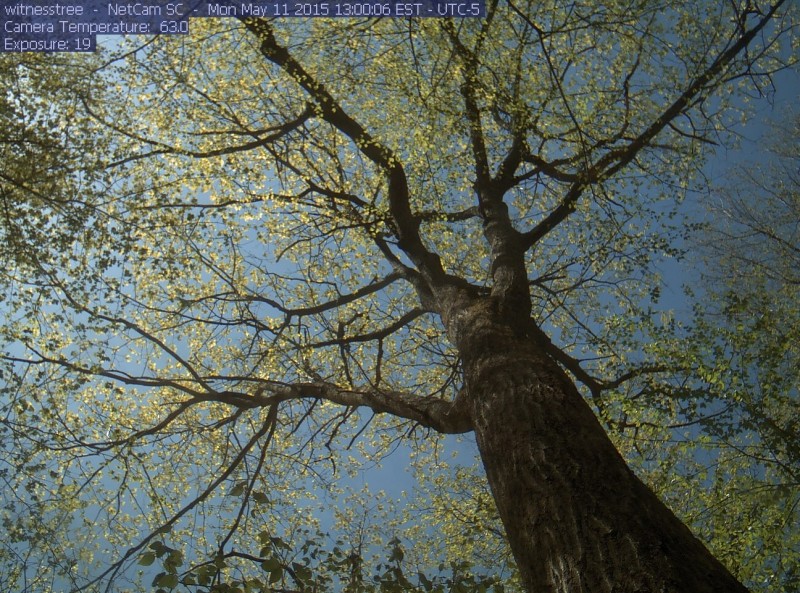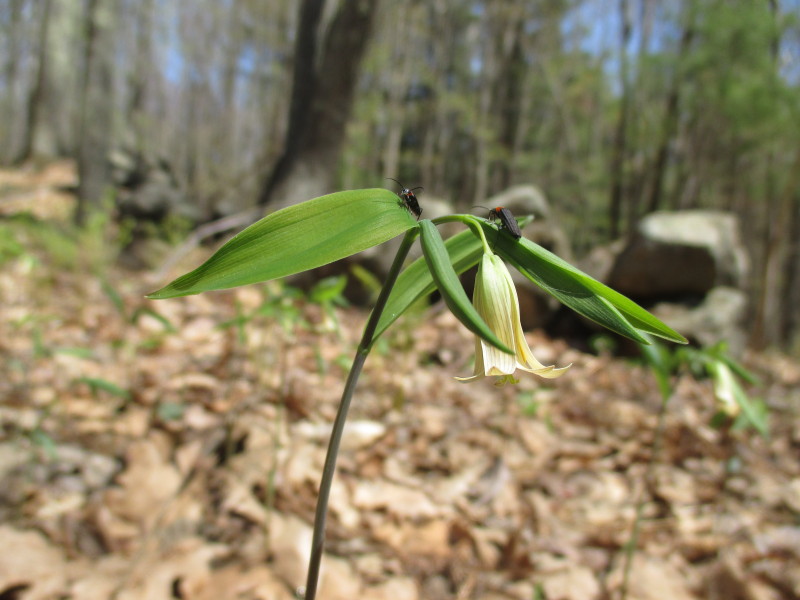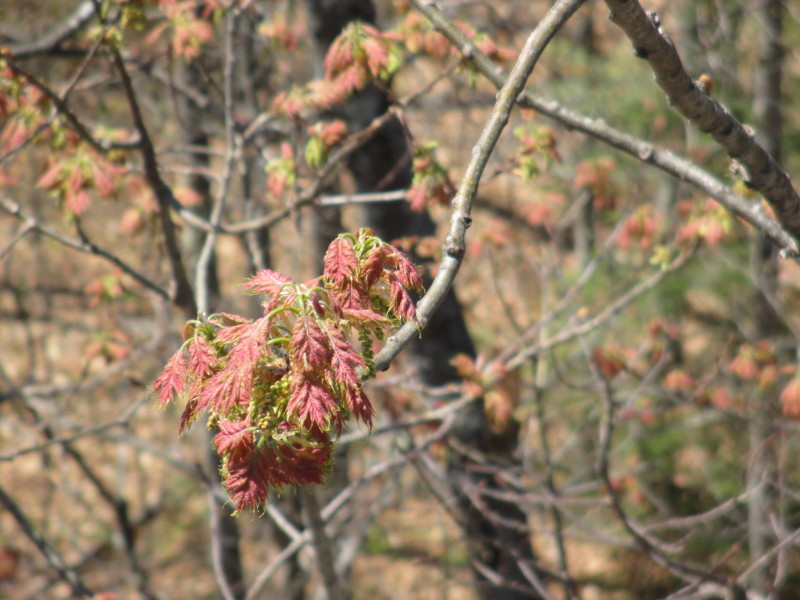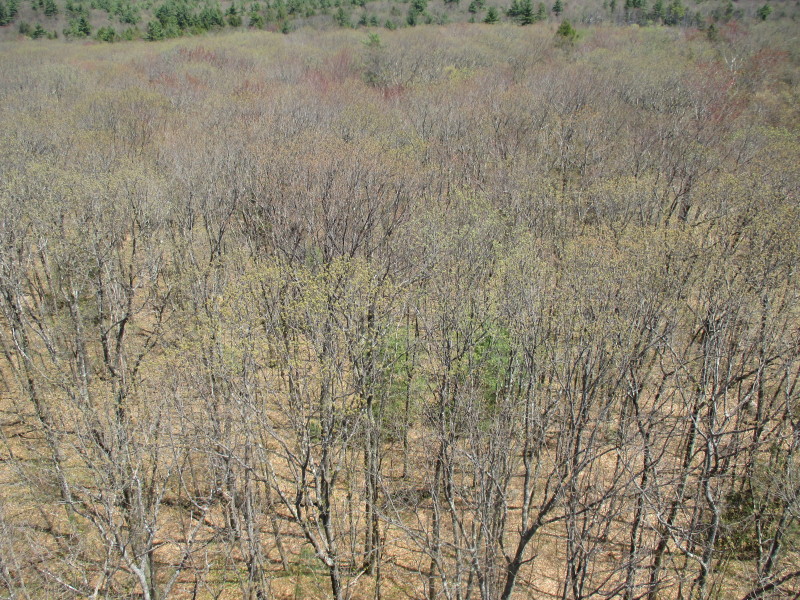A FAST-FORWARD SPRING AT THE HARVARD FOREST
Well after all that drama this year’s spring turned out to be, what would you guess….early? Late? Or just about …normal.

The red oak I am studying at the Harvard Forest for my book Witness Tree is about half into its leaves. This image is from the web cam that uploads images of the tree every half hour to the Harvard Forest home page.
Exactly. Boston saw record cold, and the Woods Crew here at the Forest – my authority on winter — can’t remember a snowier, tougher season. We all thought spring would take its sweet time.
But the big surprise is that spring at the Harvard Forest is right dead on mean average normal for the past 25 years. Not only that, but after a cool April without much happening, in May it suddenly turned and then stayed hot, with temperatures in the 70s and upper 80s, creating an unusually compressed season. A fast-forward spring. We have shot into tank top weather so fast it seems impossible that there were more than two feet of snow on the ground a month ago. Now here we are with the trees already at least half in their leaves – and some are further along than that.

A lovely sessile-leaved bellwort hosts a pair of soldier beetles. Now is the time of the spring ephemeral wildflowers, with more species coming into bloom by the day.
“It wasn’t early. It wasn’t late. But it was very compressed, that’s the takeaway,” said John O’Keefe, field phenologist at the Harvard Forest just back from surveying his trees this afternoon, tracking bud emergence and leaf growth.
Usually, it takes about three weeks or longer for all the species he tracks to leaf out. But this year just about all of the 42 trees John tracks in the spring for leaf emergence, from red oaks to beeches, birches, black cherry, red maple, paper birch, trembling aspen and striped maple broke bud within a week’s time.

Natal leaves emerge on the red oaks, pink and furry. The color and fuzz protect the young leaves from sun scald and drying winds.
“Everything was primed, and popped at once. It’s been hot, and it’s still hot today, I bet there will be more out now than when I looked this morning. I’ll bet by Friday it’s 100 percent emergence.”
John records bud break when the entire leaf is first visible, to the base of the stem. By his survey today, every tree he checks was in more than 50 percent bud break. The only laggards were one white oak, a white ash, and a red maple – only because it has so many flowers. By the next day the ash was in leaf, too.
It’s not just the trees that are booming into spring. The animals and birds are back, too. I saw a lovely garter snake today. On Saturday, visiting students from the Harvard Extension School discovered a yellow spotted and red backed salamander under a log. You can see a video made by Louise Johnson from her visit here. The warblers are out in force, and I’ve seen my first scarlet tanagers, one of the most shockingly red birds in the woods. The wood frogs are long finished calling and the ponds I check are replete with egg masses. The peepers are still going strong, even using a little pond in the cow pasture behind my house.

Viewed from the walk-up tower above the tree canopy at the Harvard Forest the red oaks are a soft sea of bloom and new leaf.
As I write this, the fragrance of Korean spice viburnum, two floors down outside the back door of Shaler Hall, is drifting in the window to my office which is deliciously wide open to the spring breeze.
Speaking of flowers. Now is the time of the spring ephemerals. Flowers and forest herbs began emerging and blooming a week ago and it won’t be long before the tree canopy closes and the show is over. Ferns are already nearly knee high.
Spring ephemeral wildflowers and herbs take advantage of the sunlight pouring through the tree canopy before the leaves are fully out. The forest floor is receiving its maximum light and sun right now – and more species are in flower by the day.
John began tracking the seasonal timing of the forest canopy and woodland shrubs in 1990. His records have become particularly valuable because he has compiled such a long record by a single observer. This was his 26th spring walking his 2.5 mile survey in the woods.

John O’Keefe explains his data collection method to visitors at the Harvard Forest. He is tracking his 26th spring at the forest this year.
Phenology – observance of biological events in nature that are influenced by climate – is an ancient practice, with new scientific relevance because it shows the influence of global change on living things. Here at the Harvard Forest, John’s data shows spring on average is arriving earlier, fall later, and winter is squeezed on both ends. The growing season over 25 years John has been observing these woods has extended by about four and a half days, with most of the extension coming with later onset of fall.

Leave a Reply